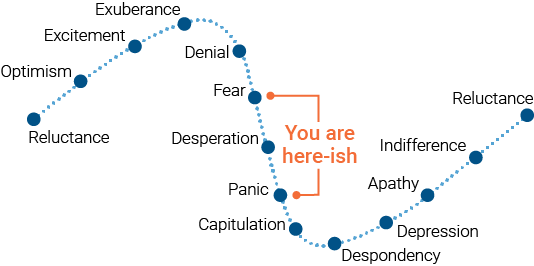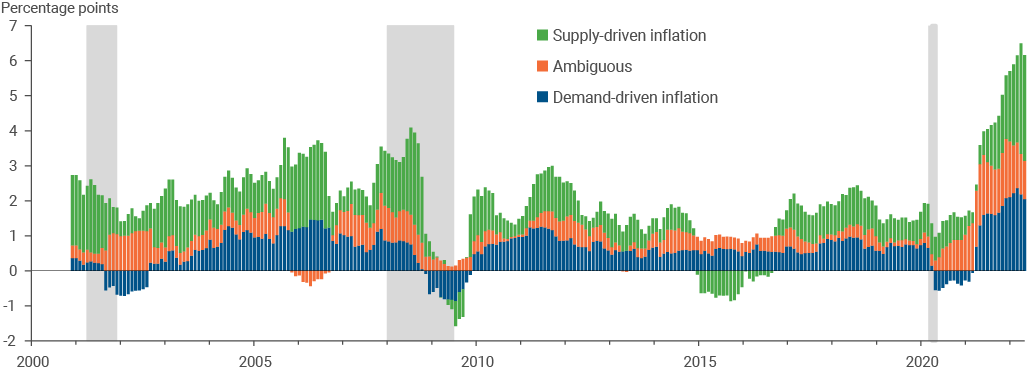Today’s Markets: Loaded for Bear

Take a deep breath. As an investor, it’s easy to feel overwhelmed by current market conditions complete with sharp daily swings in the public markets, pesky inflation issues, geopolitical uncertainties and a growing risk of recession on the horizon. But, remember, we all knew this day would come. While timing and magnitude of the correction are always a challenge to predict, the good times of low rates with lots of liquidity made it an eventual certainty that things must pull back in the other direction. So now what? As usual, we got you.
Sometimes the biggest hurdle to overcome has less to do with the tangible financial or economic issues in front of us, and more to do with what’s happening between our own two ears. The psyche of the investor can be a fragile and confounding state of affairs. Especially in a climate such as this where, for many, the natural tendency is to pull back. What past cycles have shown us (and we will get to the data in a minute) is that this is generally the wrong reaction. When others are leaning out is precisely the time one should look for the right way to lean intocertain areas. Otherwise, you run the risk of mistiming the market opportunity and/or missing out on the return benefit as things recover.
Investor Sentiment Lifecycle

Source: Barclays
It doesn’t mean there aren’t risks. As we detailed in some previous pieces on inflation last year [read Part I and Part II], the changing tide for investors means there will be more of a thematic and ‘deal-pickers’ market going forward. In other words, strategy, sector, geography and manager selection criteria will be even greater determinants of how portfolios perform relative to their collective impact over the past 13 years given a ‘rising tide’ for most asset classes. [As a side note, those previous papers featured detail on performance by strategy in a rising rate environment, which we will not cover here.]
Reality Check
Here are a couple of other realities. Returns – across all asset classes – will likely be lower going forward. It is a near statistical certainty. However, keep in mind that if we lined up and ranked the average private equity net returns over the last 30 years, four of the last five vintage years would be ranked #1, #2, #3 and #4 in that order. So, the average private equity returns, which had been hovering in the 25%-40% net IRR range over the past five vintage years, may revert to more “pedestrian” levels—in line with longer-term averages. What does that mean? The data suggests that net private equity returns on newly-invested capital over the next 5-10 years will still generate performance in the mid-to-high teens range. Still not too shabby. (And exhale...).
And how will that performance stack up to other asset classes, including the public equity markets? We would wager that private markets will meaningfully outperform public asset classes. But let ’s turn to the data on that point. While absolute levels of returns may come down, the relative outperformance of private market average returns is actually better when public returns are lower. The chart below illustrates this point: The outperformance gap that private markets have generated historically over public market equivalents tends to be higher when the public market returns (x-axis) are lower. It’s in these types of market conditions where the private market strategies have the potential to outperform the most.
3Y Excess Return by S&P 500 Return Regime
Why does private equity tend to outperform during choppy markets? Skeptics would argue that GPs are delusional, are not truly marking assets to market and would point to secondary market discounts as evidence. There is probably some truth to that. But we would argue that there are more significant factors at play. Company quality could certainly be a factor, though that is difficult to measure systematically. In some cases, GP marks are already conservative, and companies may have been on the books at lower valuations than traded comps (remember that GPs tend to exit their companies at a premium to holding value). There are also structural mechanisms that allow GPs to support their companies during times of stress that public companies don't have access to (ex. calling more capital from their LPs, better access to capital markets) that may justify higher valuations. And some would argue that the price for a highly negotiated, majority stake transaction between a small number of parties should not necessarily be the same as the price for instant liquidity of a small minority position.
Still searching for reasons to be pessimistic? Well, just pick up the newspaper or scroll through a few headlines online. The challenge for investors, and what makes periods like this so difficult, is that we are still in a climate ripe with uncertainties. Spoiler alert: Many of these uncertainties – geopolitical risks, magnitude of rate rises, timing of valuation pivots, lingering impact of COVID – are not going away anytime soon.
.jpg)
For the financial markets, arguably the biggest focal point continues to be on the impact of inflation/rising interest rates on asset prices and a potential recession looming on the horizon. First, one must acknowledge that the macroeconomic environment in Europe is meaningfully different than in other developed markets given first-order impacts from Ukraine. However, the U.S. and the Fed will likely be primary drivers of policy and approach toward tackling inflation. In that regard, the Fed is indicating that it will take whatever measures necessary to address inflation, announcing a significant 75bps rate hike in June, and with another of similar magnitude likely this week. The Fed is taking those steps even if they translate into a short, near-term recession.
Past Peak Inflation?
As we continue to breathe in and out, it is worth also keeping in mind that inflation is a lagging indicator. We have yet to see the full impact of monetary policy actions undertaken earlier this year. Commodity prices, mortgage applications and the like have already shown signs of retreating modestly in recent weeks. At the same time, other factors related to supply-driven disruptions – including inventory levels, container/freight shipping rates, transportation issues and a reopening of China – are similarly showing some early signs of easing.
As shown in the chart below from a recent Fed paper on inflation, supply-related issues currently account for more than half of the record inflation levels experienced through Q2. These areas also tend to be less ‘sticky’ relative to things like wage pressure, and so could also unwind more quickly. A reversal of this trend combined with a general slowdown on the demand side would point to more moderated inflation in the near term. Therefore, one could make the argument that peak inflation is now behind us and that actions to tighten are already starting to have the desired effect.
Supply-Driven and Demand-Driven Contributions to Year-Over-Year PCE inflation

Note: Data available at Supply- and Demand-Driven PCE Inflation. Gray shading indicates NBER recession dates.
Source: FRBSF Economic Letter, 2022-15 (June 21, 2022)
Fundamentals vs. Valuation Issues
Generally speaking, corporate business fundamentals – including earnings growth, margins and free cash flow – are also currently at historical highs. More broadly, private companies have continued to produce financial performance outpacing the growth of the public markets. This is not to say some of these fundamentals will not slow down. In many cases, it will be quite the opposite, in fact, and that is exactly what the Fed and others are hoping for. However, as an example, the majority of Hamilton Lane direct portfolio company holdings are still expecting at least high-single-digit earnings growth on average over the next 12 months. Balance sheets (for both businesses and the consumer) are also in a good spot within the historical context. In other words, businesses today have a better starting point and more cushion to weather a pending economic storm.
Furthermore, the data shows that despite a persistent rising valuation multiple environment over the past decade, private equity transactions were still purchased, on average, at a discount to public market comparable multiples.
Buyout Purchase Prices
Median EV/EBITDA by Deal Year
These two factors – strong relative earnings growth and discounted initial purchase price multiples – likely account for at least some of the ‘lag’ typically seen in valuation movements within private market portfolios through Q1 and in reading the tea leaves for Q2. On the latter point, early indications from GPs are that most private market portfolios are likely to be flat in their June 30 marks, but with notable differences across strategies (i.e., real estate portfolios will behave differently than buyout funds).
However, historical data would indicate that GPs’ directional guidance about Q2 2022 valuations may be somewhat optimistic. We’ve studied how private markets valuations tend to change given movements in relevant public market indices, and our data would suggest that private equity strategies tend to have betas close to 0.4 relative to those indices. With listed equities trading down substantially in Q2– the S&P 500 lost just over 16% of its value – the data would suggest most LP private equity portfolios to experience markdowns closer to 5%.
2022 Q2 Estimated Returns by Strategy
Peak-to-Trough and Trough-to-Peak Performance
But what about a potential recession? The markets are currently pricing in a high probability of a recession in the U.S. sometime in mid-2023 and even sooner in Europe. So, should investors be stashing cash under their mattresses? If you can time the market perfectly, go for it. Safe haven assets, like Treasuries, have historically preserved value better than riskier assets during choppy market conditions. But timing the market is a risky and short-termist game. The challenge is that being off by a few quarters or mistiming the peak or trough can lead to less-than-optimal long-term returns compared to simply staying invested. This challenge is amplified for investments in private markets, where the rebalancing mechanisms are fewer and the lag time to restart a paused program can be significant. Also, and at the risk of stating the obvious, the shape, magnitude and duration of any potential recession will matter a great deal in terms of navigating the environment and ultimate outcomes.
We’ve already covered the record private equity returns generated over the past few years. Now, take a look at the point-to-point IRR analysis below comparing the peak-to-trough for private markets performance relative to the public equity equivalent. Private markets generally lag public market downturns by two quarters, and as the data illustrates, tend to exhibit less observed volatility through the cycle. In other words, the peak-to-trough performance is not as low for private equity strategies. Moreover, the longer-term recovery wave from trough-to-peak also shows that private equity outperforms the public side (though, admittedly, private equity is a little slower out of the gate during the first few quarters of recovery). Also notable is the duration of the downturn and recovery periods, with the former typically characterized by a shorter time horizon of ~1.5-2.5 years to experience the depth of the decline. Public markets generally recover more sharply, but longer-term performance back through the peak of the recovery period also favors private equity.
Point-to-Point IRR Per Performance
Private Equity Outperformance (bps)
Tech bust from 4/1/2000 - 9/30/2002
Post-tech bust boom from 10/1/2002 - 9/30/2007
GFC from 10/1/2007 - 3/31/2009
Post-GFC Boom from 4/1/2009 - 12/31/2021
History Never Repeats, but It Does Often Rhyme…
In our view, the current market dynamics look and feel much more like any potential recession will be similar to the 2000s tech/valuation reset, rather than the GFC. Here are a few reasons why:
- Similarities to 2000: Excess capital; innovation via tech enablement; FOMO in deal making; paper gains; too many companies chasing the same market; huge public market appetite for growth at any cost, defined by a valuation correction; heightened geopolitical risks characterized by major military events.
- Differences from 2000: More capital in various private market strategies; stronger business fundamentals – revenue, earnings, margins, transactions in high-quality businesses with long-term reasons to exist (relative to dot-com era companies).
- Why not GFC 2.0? Not a broader financial market stability issue; a financial crisis and debt default-driven cycle in 2007; better corporate and consumer balance sheets today.
Conclusion
It is more likely than not that we are headed for a moderate downturn. Importantly, we don’t believe this will be a GFC-like recession with that caliber of carnage across nearly all sectors and asset classes. Rather, performance from here is likely to be driven by more specific and tactical investment considerations. The industry, geography and strategy profile will more meaningfully dictate delineation of returns as the tide goes out. The tried-and-true method of staying invested and not timing the market will also likely be the better longer-term path for most investors. In other words, breathe deeply and stay the course. Over the long term, you will be happy that you did.
The projections published herein are based on a regression of quarterly public market index returns against quarterly private market index returns. This regression generates an alpha and a beta by strategy which can be used as inputs into the single-index model of pricing assets (Sharpe 1964, Lintner 1965). The formula for the single-index model is:
𝑟𝑃𝑟𝑖𝑣𝑎𝑡𝑒 𝑀𝑎𝑟𝑘𝑒𝑡𝑠=𝛼𝑃𝑟𝑖𝑣𝑎𝑡𝑒 𝑀𝑎𝑟𝑘𝑒𝑡𝑠+𝛽𝑃𝑟𝑖𝑣𝑎𝑡𝑒 𝑀𝑎𝑟𝑘𝑒𝑡𝑠(𝑟𝑃𝑢𝑏𝑙𝑖𝑐 𝑀𝑎𝑟𝑘𝑒𝑡𝑠−𝑟𝑅𝑖𝑠𝑘 𝐹𝑟𝑒𝑒)+𝑟𝑅𝑖𝑠𝑘 𝐹𝑟𝑒𝑒
Where:
𝑟𝑃𝑟𝑖𝑣𝑎𝑡𝑒 𝑀𝑎𝑟𝑘𝑒𝑡𝑠=𝑅𝑒𝑡𝑢𝑟𝑛 𝑜𝑓 𝑡ℎ𝑒 𝑃𝑟𝑖𝑣𝑎𝑡𝑒 𝑀𝑎𝑟𝑘𝑒𝑡𝑠
𝑟𝑃𝑢𝑏𝑙𝑖𝑐 𝑀𝑎𝑟𝑘𝑒𝑡𝑠=𝑅𝑒𝑡𝑢𝑟𝑛 𝑜𝑓 𝑡ℎ𝑒 𝑃𝑢𝑏𝑙𝑖𝑐 𝑀𝑎𝑟𝑘𝑒𝑡𝑠
𝛼𝑃𝑟𝑖𝑣𝑎𝑡𝑒 𝑀𝑎𝑟𝑘𝑒𝑡𝑠=𝐴𝑙𝑝ℎ𝑎 𝑜𝑓 𝑡ℎ𝑒 𝑃𝑟𝑖𝑣𝑎𝑡𝑒 𝑀𝑎𝑟𝑘𝑒𝑡𝑠
𝛽𝑃𝑟𝑖𝑣𝑎𝑡𝑒 𝑀𝑎𝑟𝑘𝑒𝑡𝑠=𝐵𝑒𝑡𝑎 𝑜𝑓 𝑡ℎ𝑒 𝑃𝑟𝑖𝑣𝑎𝑡𝑒 𝑀𝑎𝑟𝑘𝑒𝑡𝑠
𝑟𝑅𝑖𝑠𝑘 𝐹𝑟𝑒𝑒=𝑅𝑖𝑠𝑘 𝐹𝑟𝑒𝑒 𝑅𝑎𝑡𝑒
The regression formulas for Core and Non-Core Real Estate differ slightly from the single-index model in that the regressions are multi-index models, which include multiple betas and public market returns to better predict private market returns, such as the U.S. Regression Indicator Index.
Once all inputs are obtained, we create a 75% confidence interval for our expected returns. This should denote the inherent uncertainty in these sorts of predictions. In general, we expect to be accurate within a 400 basis point spread with 75% confidence in quarters of normal stock market volatility. During periods of outsized positive or negative returns in the public markets, we would expect to either be less accurate or for the confidence interval to expand meaningfully. We also expect individual portfolios to vary meaningfully from these projections, as individual portfolio returns vary from the industry’s returns for many reasons, including concentration of assets, different investment pacing, and different strategy/geography makeups, to name a few. Larger and more mature portfolios should be expected to have a performance more similar to the market, and therefore more reflective of these estimates, than other portfolios might be.
To estimate the next quarter’s valuation for a portfolio, you can apply the estimated quarterly growth rate associated with it. The quarterly growth rate should be applied after adjusting for all fund contributions and distributions made during the quarter, in accordance with the Simple-Dietz methodology for calculating returns. Note that all calculations shown in the document are in USD. Therefore, the formula for calculating 𝑟𝑃𝑟𝑖𝑣𝑎𝑡𝑒 𝑀𝑎𝑟𝑘𝑒𝑡𝑠 shown above yields a return in USD. To apply the 𝑟𝑃𝑟𝑖𝑣𝑎𝑡𝑒 𝑀𝑎𝑟𝑘𝑒𝑡𝑠 to a portfolio with valuation and cash flow information already in USD, use the formula below:
P𝑟𝑒𝑑𝑖𝑐𝑡𝑒𝑑 𝑁𝐴𝑉𝐸𝑛𝑑𝑖𝑛𝑔=(𝑁𝐴𝑉𝐵𝑒𝑔𝑖𝑛𝑛𝑖𝑛𝑔)(1+𝑟𝑃𝑟𝑖𝑣𝑎𝑡𝑒 𝑀𝑎𝑟𝑘𝑒𝑡𝑠)+ ((1+𝑟𝑃𝑟𝑖𝑣𝑎𝑡𝑒 𝑀𝑎𝑟𝑘𝑒𝑡𝑠)/2)(𝑃𝑒𝑟𝑖𝑜𝑑 𝐶𝑎𝑝𝑖𝑡𝑎𝑙 𝐶𝑎𝑙𝑙𝑠‐𝑃𝑒𝑟𝑖𝑜𝑑 𝐷𝑖𝑠𝑡𝑟𝑖𝑏𝑢𝑡𝑖𝑜𝑛𝑠)
If the portfolio valuation and cash flow information is not in USD OR you wish to convert a USD return to a non-USD currency, an “FX Effect” factor must be applied. The formula should be adjusted as shown below:
𝑃𝑟𝑒𝑑𝑖𝑐𝑡𝑒𝑑 𝑁𝐴𝑉𝐸𝑛𝑑𝑖𝑛𝑔=(𝑁𝐴𝑉𝐵𝑒𝑔𝑖𝑛𝑛𝑖𝑛𝑔)(1+𝑟𝑃𝑟𝑖𝑣𝑎𝑡𝑒 𝑀𝑎𝑟𝑘𝑒𝑡𝑠+𝐹𝑋 𝐸𝑓𝑓𝑒𝑐𝑡)+ (1+(𝑟𝑃𝑟𝑖𝑣𝑎𝑡𝑒 𝑀𝑎𝑟𝑘𝑒𝑡𝑠+𝐹𝑋 𝐸𝑓𝑓𝑒𝑐𝑡)/2)(𝑃𝑒𝑟𝑖𝑜𝑑 𝐶𝑎𝑝𝑖𝑡𝑎𝑙 𝐶𝑎𝑙𝑙𝑠‐𝑃𝑒𝑟𝑖𝑜𝑑 𝐷𝑖𝑠𝑡𝑟𝑖𝑏𝑢𝑡𝑖𝑜𝑛𝑠)
Definitions
Strategy Definitions:
All Private Markets: Hamilton Lane’s definition of “All Private Markets” includes all private commingled funds excluding fund-of-funds, and secondary fund-of-funds.
Credit: This strategy focuses on providing debt capital.
EU Buyout: Any buyout fund primarily investing in the European Union.
Mega/Large Buyout: Any buyout fund larger than a certain fund size that depends on the vintage year.
Real Estate: Any closed-end fund that primarily invests in non-core real estate, excluding separate accounts and joint ventures.
SMID Buyout: Any buyout fund smaller than a certain fund size, dependent on vintage year.
VC/Growth: Includes all funds with a strategy of venture capital or growth equity.
Index Definitions:
MSCI Europe Index: The MSCI Europe Index tracks large and mid-cap equity performance across 15 developed market countries in Europe.
MSCI World Index: The MSCI World Index tracks large and mid-cap equity performance in developed market countries.
S&P 500 Index: The S&P 500 Index tracks 500 largest companies based on market capitalization of companies listed on NYSE or NASDAQ.
This presentation has been prepared solely for informational purposes and contains confidential and proprietary information, the disclosure of which could be harmful to Hamilton Lane. Accordingly, the recipients of this presentation are requested to maintain the confidentiality of the information contained herein. This presentation may not be copied or distributed, in whole or in part, without the prior written consent of Hamilton Lane.
The information contained in this presentation may include forward-looking statements regarding returns, performance, opinions, the fund presented or its portfolio companies, or other events contained herein. Forward-looking statements include a number of risks, uncertainties and other factors beyond our control, or the control of the fund or the portfolio companies, which may result in material differences in actual results, performance or other expectations. The opinions, estimates and analyses reflect our current judgment, which may change in the future.
All opinions, estimates and forecasts of future performance or other events contained herein are based on information available to Hamilton Lane as of the date of this presentation and are subject to change. Past performance of the investments described herein is not indicative of future results. In addition, nothing contained herein shall be deemed to be a prediction of future performance. The information included in this presentation has not been reviewed or audited by independent public accountants. Certain information included herein has been obtained from sources that Hamilton Lane believes to be reliable, but the accuracy of such information cannot be guaranteed.
This presentation is not an offer to sell, or a solicitation of any offer to buy, any security or to enter into any agreement with Hamilton Lane or any of its affiliates. Any such offering will be made only at your request. We do not intend that any public offering will be made by us at any time with respect to any potential transaction discussed in this presentation. Any offering or potential transaction will be made pursuant to separate documentation negotiated between us, which will supersede entirely the information contained herein.
Certain of the performance results included herein do not reflect the deduction of any applicable advisory or management fees, since it is not possible to allocate such fees accurately in a vintage year presentation or in a composite measured at different points in time. A client’s rate of return will be reduced by any applicable advisory or management fees, carried interest and any expenses incurred. Hamilton Lane’s fees are described in Part 2 of our Form ADV, a copy of which is available upon request.
The following hypothetical example illustrates the effect of fees on earned returns for both separate accounts and fund-of-funds investment vehicles. The example is solely for illustration purposes and is not intended as a guarantee or prediction of the actual returns that would be earned by similar investment vehicles having comparable features. The example is as follows: The hypothetical separate account or fund-of-funds consisted of $100 million in commitments with a fee structure of 1.0% on committed capital during the first four years of the term of the investment and then declining by 10% per year thereafter for the 12-year life of the account. The commitments were made during the first three years in relatively equal increments and the assumption of returns was based on cash flow assumptions derived from a historical database of actual private equity cash flows. Hamilton Lane modeled the impact of fees on four different return streams over a 12-year time period. In these examples, the effect of the fees reduced returns by approximately 2%. This does not include performance fees, since the performance of the account would determine the effect such fees would have on returns. Expenses also vary based on the particular investment vehicle and, therefore, were not included in this hypothetical example. Both performance fees and expenses would further decrease the return.
Hamilton Lane (Germany) GmbH is a wholly-owned subsidiary of Hamilton Lane Advisors, L.L.C. Hamilton Lane (Germany) GmbH is authorised and regulated by the Federal Financial Supervisory Authority (BaFin). In the European Economic Area this communication is directed solely at persons who would be classified as professional investors within the meaning of Directive 2011/61/EU (AIFMD). Its contents are not directed at, may not be suitable for and should not be relied upon by retail clients.
Hamilton Lane (UK) Limited is a wholly-owned subsidiary of Hamilton Lane Advisors, L.L.C. Hamilton Lane (UK) Limited is authorised and regulated by the Financial Conduct Authority (FCA). In the United Kingdom this communication is directed solely at persons who would be classified as a professional client or eligible counterparty under the FCA Handbook of Rules and Guidance. Its contents are not directed at, may not be suitable for and should not be relied upon by retail clients.
Hamilton Lane Advisors, L.L.C. is exempt from the requirement to hold an Australian financial services licence under the Corporations Act 2001 in respect of the financial services by operation of ASIC Class Order 03/1100: U.S. SEC regulated financial service providers. Hamilton Lane Advisors, L.L.C. is regulated by the SEC under U.S. laws, which differ from Australian laws.
Any tables, graphs or charts relating to past performance included in this presentation are intended only to illustrate the performance of the indices, composites, specific accounts or funds referred to for the historical periods shown. Such tables, graphs and charts are not intended to predict future performance and should not be used as the basis for an investment decision.
The information herein is not intended to provide, and should not be relied upon for, accounting, legal or tax advice, or investment recommendations. You should consult your accounting, legal, tax or other advisors about the matters discussed herein.
The calculations contained in this document are made by Hamilton Lane based on information provided by the general partner (e.g. cash flows and valuations), and have not been prepared, reviewed or approved by the general partners.
As of July 8, 2022

